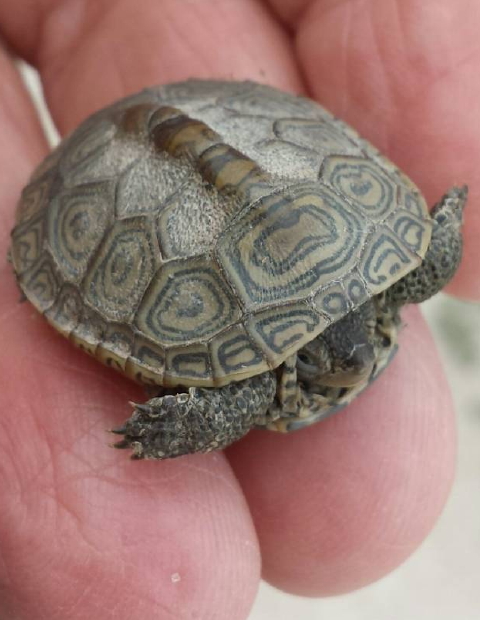Diamondback Terrapin (Malaclemys terrapin) Hatchling
Warmer temperatures, a threat of thunderstorms to trigger barometric changes and gentle showers have enticed tiny Northern diamondback terrapin (Malaclemys terrapin terrapin) hatchlings to emerge from their over-wintered upland sites. Â When born in the late summer and early fall, some number of terrapin hatchlings head upland rather than directly into the nursery salt marsh. Â They burrow down in coastal dunes, banks and dirt roadways for the winter. Â In May, as weather conditions improve, these vulnerable little critters scramble to the surface.
Diamondback Terrapin Hatchling Track
They employ a mathematical technique sometimes called the Drunkard’s Walk, crawling in random directions with slow curves to accommodate the rolling topology of the dunes, seeking to reach safety in the salt marsh. Â The trek is treacherous with legions of predators looking for a tasty snack. Â Dehydration is an enormous risk in this desert like terrain. Â In the track pictured above, the hatchling is traveling from bottom to top. Â You can easily detect the tail drag that bisects the track. Â We discovered the hatchling track as we patrolled coastal dunes about a quarter mile from the marsh.
Diamondback Terrapin Hatchling “Hiding” on Dune
The tracks continued for at least a tenth of a mile before the hatchling took temporary refuge under some sparse dune plants. Â As you can see in the image above, the hatchlings followed the old turtle axiom, “If I can’t see you, then you can’t see me.” Â Yet, it is truly amazing how these hatchlings blend so completely into the background and disappear among little camouflaging vegetation.
 Becky Wieber Nourse Discovers Terrapin Hatchling
Fortunately, eagle-eyed Becky Wieber Nourse spotted the hatchling who had obviously tired of its long, long trek. Â A cursory examination indicated that the baby had become quite dehydrated by exertion and weather conditions. Â We believe it unlikely that this hatchling would have successfully completed its journey to the nursery salt marsh.
Rufus the Turtle Dog Guards Terrapin Hatchling
Rufus the Turtle Dog immediately assumed ownership. Â She stood guard over the hatchling to ensure its safety as the rest of the team documented the find.
Don Lewis Documents Terrapin Hatchling in Situ
The team recorded tracks and surrounding habitat. Â The specific location was GPS’d and then scientific data on the hatchling itself was derived.
Tiny Diamondback Terrapin Hatchling
Like most Cape Cod hatchlings, this specimen’s carapace (top shell) measured almost exactly one inch (2.54 centimeters). Â It weighed a mere 5 grams (less than 0.2 ounce), probably indicating a loss of 15% or more of its original body mass likely due to dehydration.
Diamondback Terrapin Hatchling Carapace (Top Shell)
The carapace (top shell) showed a scutal anomaly with seven vertebral (center) scutes rather than the normal five. Â The hatchling also has a split nuchal, the frontmost marginal scute, and a split “90” marginal, the left rearmost marginal scute. Â
Diamondback Terrapin Hatchling Plastron (Bottom Shell)
The plastron (bottom shell) still shows the remnants of a once generous yolk sac, “given” to the hatchling by its mother and which provided nutrients to endure the first fall and winter. Â The opening for the yolk sac in the center of the hatchling’s abdominal scutes is beginning to close. Â To compensate for dehydration and to provide this tiny hatchling with better odds of survival, we allowed it to soak in warm fresh water over night before releasing it directly into the nursery salt marsh that it had struggled so valiantly to reach.
Tiny Diamondback Terrapin (Malaclemys terrapin) Hatchling
We’ve now entered the season for over-wintered hatchlings to emerge and meander to the safety of the nursery salt marsh. Â As you walk, bike and drive coastal uplands of Southeast Massachusetts, look down and save a baby turtle. Â Who knows? Â Saving that one turtle may be the tipping point in saving the world … from the turtle’s perspective, at least. Â If you need advice or assistance, call the Turtle Journal team at 508-274-5108.









